"You may stretch yourself out on a piece of
carpet in some nook or corner, and watch the ever varying group and the
succession of strange, wild faces for hours with unflagging interest.
Representatives of all the people of Central Asia may be found in the
motley crowd."
JA Macgahen 'Campaigning on the Oxus and the fall of Khiva' 1874
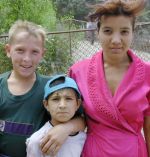 'Complexions and colourings vary widely' |
Ask the average Uzbek in Tashkent or in the Fergana
Valley what they think about people from Khorezm and they will tell you,
"They're different from us. They speak their own language and have
their own customs." Khorezmliks (people from Khorezm) will also attest
to this fact, proudly citing their distinct culture and a dialect that
could almost be classified as a different language.
Due to its isolated location, Khorezm has produced a unique culture which
is closer to its nomadic Turkoman and Karakalpak neighbours than the more
Persian-influenced cities of Bukhara and Samarkand. Likewise Khorezmliks
have maintained a purer form of Chaghatay Turki or old Uzbek than other
regions with far less Persian and Arabic loan words.
In terms of religion, Khorezm never embraced Islam to the same passionate
extent as other regions such as Bukhara, Kokand and Samarkand and as a
result music and dance flourished much more freely. Khorezmliks are also
more laid back concerning hospitality and other traditions. For example,
in other parts of the country guests will hear 'oling, oling' (take, take)
while their cup is at their lips while in Khorezm guests have their own
teapots and can serve themselves.
Arminius Vambery, the Hungarian dervish cum spy, took a liking to the
people of Khorezm and preferred them to the cultured hypocrisy of the
more Persian -orientated cities of Bukhara and Samarkand:
"Even in the traits of his character, the Khivan Uzbek is preferable
to his relatives in the other races. He is honest and open hearted, has
the savage nature of the nomads that surround him without the refined
cunning of oriental civilisation. He ranks next to the pure Osmanli of
Turkey, and it may be said of both that something might still be made
out of them."
Arminius Vambery 'Travels in Central Asia' 1864
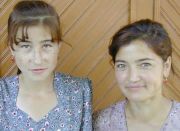 'Some Khorezmliks have inherited the fairer complexions and blue eyes of Alexander the Great's army which took many wives whilst in Khorezm' |
Whilst the people of Khorezm are easily marked out by their accents, they are not so easy to distinguish racially. Conquered by Alexander the Great from the west and Genghis Khan from the east and influenced by large Persian and Kurdish slave populations, Khorezmliks vary widely in appearance. The Macedonian features of Alexander's armies have left their legacy and many Khorezmliks have lighter hair and blue eyes. Complexions vary widely from the darker tones of the Persian and Kurdish slave descendants to the yellower tones of the Mongols and the lighter tones of the original Turki people.
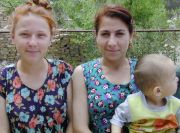 'Complexions and colourings vary widely' |
Today people call themselves Khorezmliks regardless of whether they have a Persian, Mongolian, Turkoman or Kurdish background and many people do not know their own particular racial heritage. However in the 1830's clearer distinctions existed between the different people groups living in the Khiva khanate. Captain Muraviev identified four different races.
"Khiva is inhabited by four different races:
1) The Sarts, who are the aboriginal inhabitants of the country.
2) The Karakalpaks, nomads who wander in the neighbourhood of the Sarts,
and are greatly under their influence.
3) The Uzbegs; foreigners who have conquered and possessed themselves
of the country.
4) The Turkomans, who are divided into many tribes, and have been tempted
by motives of profit (commercial and other) to settle a nomadic life in
the State.

|
The relation of the four races to one another used,
at first, to be as follows:
1) Noble
2) Servant
3) Conqueror
4) Guest
By and by, however, as the nation grew more closely welded together and
became one great whole, the old distinctions disappeared and the classification
became as follows:
1) Merchant
2) Agriculturist
3) Noble
4) Warrior"
Nicolai Muraviev 'Journey to Khiva through the Turkoman Country' (English
Edition) 1871
However Vambery perceived fewer racial distinctions, commenting instead
on the racial purity of the people of Khiva.
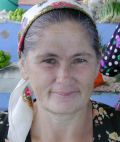 'A Tartar woman in Khiva' |
"The Khivite has a legitimate pride in the
purity of his ancient Uzbek nationality, as contrasted with that of Bukhara
and Kashgar. At the very first sight, however, the Khivan betrays the
mixture of his blood with the Iran elements, for he has a beard, always
to be regarded by the Turanis as a foreign peculiarity, but his complexion
and form of countenance indicate very often genuine Tartar origin."
Arminius Vambery 'Travels in Central Asia' 1864
In 1924 Stalin bundled together the Khorezmliks with
the mixture of peoples living from the Aral Sea to the Fergana Valley
in order to form the new republic of Uzbekistan. Today, seventy years
after Soviet rule, the government of modern Uzbekistan is pursuing a proactive
nationalistic policy in an attempt to rediscover what it means to be 'Uzbeg'
(pronounced in other regions: Uzbek) which literally means, 'ruler of
self'. Unfortunately the large Tajik and Kazakh minorities are often discriminated
against and so many have 'Uzbek' written in their passport in order to
find work. However this process of 'uzbekification' of other ethnic groups
within the region is actually nothing new.
"As the Uzbegs have been for hundreds of years the dominant race
in Turkestan and adopted the institutions of Islam earlier than any other
nomad people of these parts, the name itself has become invested with
a certain prestige of breeding and 'bon ton', so that the Kirghiz, Kiptchak
and Kalmuk, from the moment that they settle in cities, generally abandon
their several nationalities and assume the denomination of Uzbegs."
Arminius Vambery 'Travels in Central Asia' 1864
Nowadays 95.5% of people in Khorezm call themselves Uzbek; the highest
percentage in Uzbekistan. However there continues to be different regions
within Khorezm where descendants of other races predominate. Towns such
as Hanka have high percentages of ethnic Turkomans whilst Koshkopir contains
a large population of darker, Iranian descendants of the freed Persian
slaves.
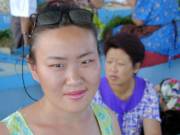 'Some of the ethnic Koreans still living in Khorezm' |
The more obvious minority groups are the Russians and
Koreans who settled in Khorezm during the Soviet era. They now find themselves
at a distinct disadvantage since many are unable to speak Uzbek. Whilst
Russians are often resented as the colonial oppressors the Koreans, who
were deported from North Korea to Central Asia by Stalin, are treated
with more acceptance despite the fact that they have adopted the Russian
language. There are also a number of Tartars living in Urgench from both
Kazan in Russia and the Crimea. Most Tartars are more russified than other
Turkic people but often intermarry with Uzbeks and are predominantly Muslim
in religion.
Racism amongst Uzbeks in Khorezm is prevalent and there is a definite
pecking order. Russian women are considered loose and immoral but Russians
are often regarded as more trustworthy in business matters than their
fellow Uzbeks. Khorezmliks with more oriental features are mocked as foreign
Mongols whilst darker skinned people are considered ugly and certainly
not a good wedding match. In addition they are mistrusted as their dark
skin is attributed to the overflow of a dark heart and are often derided
because many have descended from the darker skinned Kurdish and Persian
slaves.
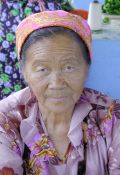 'Some of the ethnic Koreans still living in Khorezm' |
Just over the border in Turkmenistan, the Khorezmliks
are racially the same and make up the majority of the population in the
regional capital of Dashaouz. During the Soviet era it made little difference
on which side of the border people lived, but with the collapse of the
Soviet Union and an increase in border restrictions, Khorezmliks in Turkmenistan
have felt increasingly isolated.
The Khorezmian cultural identity, forged from the various peoples living
in the Khiva khanate, remained intact despite the cultural onslaught of
Soviet values and russification. However the challenge now is whether
it will endure the aggressive nationalist policies of Turkmenistan and
Uzbekistan which have split it down the middle.
| Gudebook Links: | |
| Freeing of the Slaves | |
| Hospitality | |
| The Last Khans | |
| The Silk Road | |